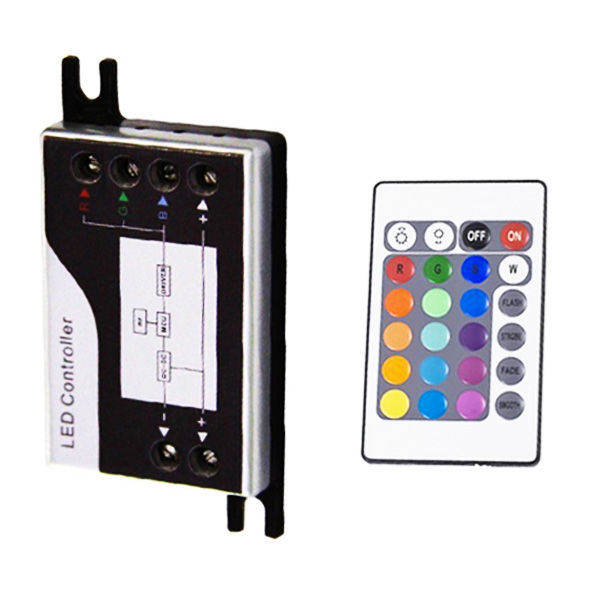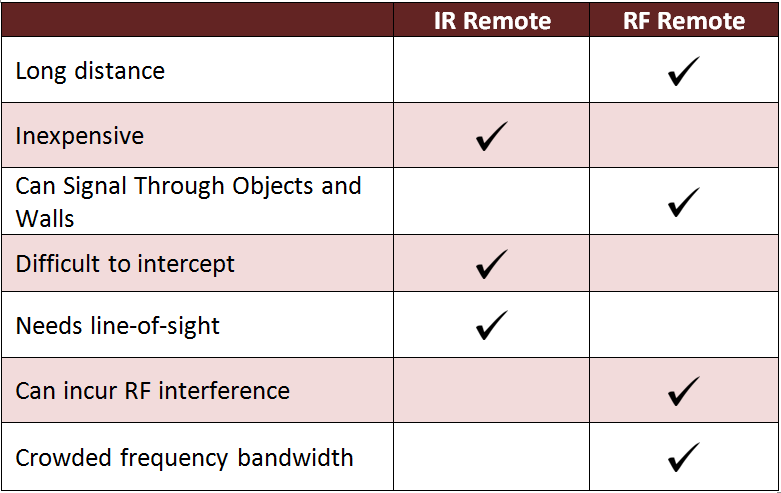IR vs. RF Remotes – What’s the Difference?
There is something quietly satisfying about using a remote. The effortless push of a button can trigger marvelous light displays or launch your favorite TV show. There are several advantages and disadvantages to the type of remote you use for your electronics. With this in mind, we specifically want to compare the pros and cons of infrared (IR) and radio frequency (RF) remotes for lighting installations.
RGB controller and IR remote for LED strip lights
If you currently have a TV, stereo system, or any sort of remote control, then you likely have either an infrared or radio frequency remote. The more common and less expensive IR remotes send infrared light waves to IR photodiodes on your device, such as an RGB controller. The signals are uni-directional or “one way” and must be directed where you want them to go. Since infrared is a light wave, the signal is limited in distance and cannot be sent through walls or other solid objects. This is called line-of-sight. Although objects can block the signal, it is also difficult to intercept or hack and doesn’t suffer from interference from other electronic signals. However, heat sources and sunlight can interfere with the light waves.
RF remotes use specific radio frequencies, typically a license-free 2.4 GHz bandwidth, to transmit a signal to a receiving device. The signals are able to be sent through objects like walls and furniture, extending the remote’s range. Conversely, the radio frequency bandwidth is very crowded. The Bluetooth from your phone, the Wi-Fi on your laptop, and sometimes even your garage door opener are all using RF signals to operate. This means RF remotes are more expensive because there are fewer frequencies for them to use and they still may experience interference from other RF devices. This interruption is called radio frequency interference, or RFI, and is difficult to block or shield against because of the suffusive nature of RF waves. This chart sums up the differences between the two remotes.
What Kind of Remote Do I Need?
An RF remote for LED strip lights
Generally in lighting, such as LED strip lights or RGB flood fixtures, a remote is the best choice when you need a controller in situations too sporadic for a timer. You want to use an IR remote when you are able to be close to the device. Your television, sound system, and several other kinds of AV equipment usually use IR remotes. Moreover, the backlighting on the TV or the cove lighting in your living room ceiling could be run with an IR remote where the receiver is visible. IR remotes for lighting systems are also ideal in environments like hospitals or airports, where signal interference could cause problems. RF remotes are remotes of convenience, better suited to those moments when you won’t or can’t get close to the receiver, such as outdoor Christmas displays or a grand opening. The most important things to consider is the location of the equipment and where you will be controlling it. If it is a short distance without obstacles or solid obstructions, then you can use an IR remote, but if you need more flexibility, choose the RF remote control system.
Do you have any tips on shielding RF remotes from interference? Leave your advice in the comment area below. As always, check out our Facebook, Twitter, LinkedIn, or Pinterest for more everyday lighting solutions, knowledge, and DIY ideas.









